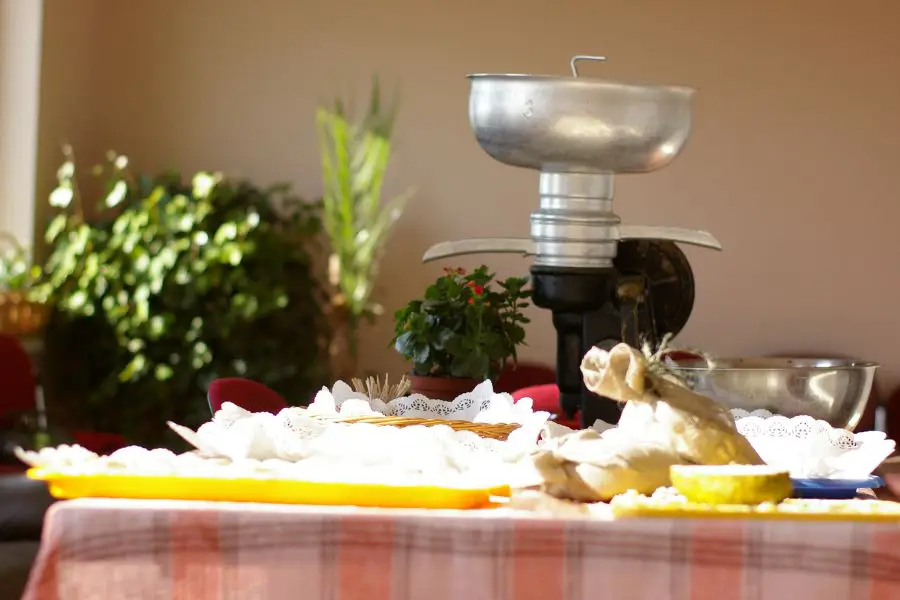With dairy goats becoming increasingly popular for homesteads throughout the United States, there are more of us interested in making goat cheese or butter. Besides its unique flavor, goat milk and its dairy products are much easier on human digestive systems. But separating goat cream from the milk takes time and a lot of refrigerator space if you use the cold standing method.
A cream separator will separate goat milk and cream faster than the cold-standing method of cream separation. The cream separator should be set to its finest setting to remove goat milk's tiny, homogenized fat particles. Separating less goat milk at a slightly slower rate should yield more cream.
Using a cream separator at home allows you to experiment to get the best yield suited for your needs. For example, some people want as much cream as possible to make goat butter or ghee. Others want to leave some fat in the milk for drinking. Whatever the need, a cream separator speeds up the separation and standardization process of goat milk.
A Cream Separator Will Work On Goat Milk

Even though goat's milk is denser than cow's milk, a cream separator will do a splendid job of separating it. Many dairy farmers consider cream separators more practical for separating goat milk than cold separation. This is because cream separators work much faster and more efficiently than the cold separation method, plus the process doesn't require as much space.
Cream separators can be manually or electrically powered. Some people prefer manual cream separators for goat milk because they can spin the drum at a lower speed and extract more cream. Small-scale electrical cream separators do not have the option of varied rates. When turned on, they will spin at maximum speed, which isn't always ideal for separating goat milk.
How Does A Cream Separator Separate Goat Milk?
The centrifugal force created in a cream separator is particularly efficient at separating the tiny fat particles in goat milk. As whole goat milk enters the spinning drum, it is fed through aligned cones in thin sheets. At the high rotation speed of 6,000 to 8,000 rpm (or more in some models), the cream separates from the milk because of its lighter density.
The lower-density cream moves towards and up the center spindle to the cream outlet, while the denser skimmed milk leaves through the other outlet.
Cream separators allow you to standardize the amount of cream you want to extract from the whole milk or how much you want to leave in the milk. For goat milk, you can set it on maximum extraction because a fair amount will still be left behind after separation. You could even run the skimmed milk through a second time to see if more cream can be extracted.
Tips For Using A Cream Separator With Goat Milk
Whether you have your cream separator yet or still need to get one, you'll most likely want to get the most cream out of it. Below are some useful tips for getting the most cream from goat milk.
- When pouring the goat milk into the funnel, adjust the valve so that the milk runs through slowly. More cream can be separated when there is less whole milk in the centrifuge drum. By feeding the milk in slower, you should be able to get about a quart of cream from three gallons of whole milk.
- Adjust the cream thickness setting using the screw on the drum. For goat milk, the finest setting will give you a higher cream yield.
- Warm the goat milk to about 90°F to make the separation process more effective. Some say even as high as 104-113°F is suitable. If the milk is too cool, it won't separate as well. However, if the milk is too hot, it might alter the taste of the milk. Warming the milk before using a cream separator is recommended because it makes the lower-density fat globules more "fluid."
- Keep your speed consistent when cranking the handle (manual separator). You can start at a slower speed and increase the pace until the cream runs at a constant rate.
- Empty the bowl of the centrifuge drum of accumulated skim milk before starting a new separation batch to prevent flooding.
- Wash your centrifuge drum and any significant spills on average for every hour of use. Residue builds up inside and hinders the paths of the cream and skimmed milk unless washed away.
- Be patient. Separating goat milk takes longer than separating cow's milk because of the smaller fat globules.
- Experiment with the rotation speed and the number of cones you put into the centrifuge drum. Some recommend removing a cone and cranking at just under 60 rpm (manual separator) to increase the cream yield.
Discover the ultimate guide to selecting the best milk separator for your needs - read our post on recommended milk separators now!
Why Is Goat Milk More Challenging To Separate?
Compared to cow's milk, goat milk takes longer to separate during the cold separation method and while using a cream separator. But why is it like that?
Goat Milk Is Naturally Homogenized
Natural, whole goat milk is naturally homogenized, meaning the tiny fat particles are evenly distributed throughout the milk during milking. However, as with any whole milk, the particles within it will separate according to density when it is left to stand. For example, the smaller cream particles in goat's milk take longer to rise to the surface than the larger fat globules in cow's milk.
The Fat Particles In Goat Milk Are Smaller
Because the less-dense fat particles in goat milk are so small, they take longer to rise to the surface of the milk. As the fat particles emulsify into larger globules, they move to the milk's surface faster.
Goat Milk Is Denser Than Other Milks
Because goat milk is naturally homogenized, it is denser than cow's milk. The thick density of goat milk makes it more challenging to separate. As mentioned, the separation process can take days if left to stand.
When using a cream separator with goat milk, the process is faster than the standing method. However, you would have to feed the milk through the cream separator slower to maximize separation. The higher density of goat milk does make manual cream separation a bit more difficult. However, a manual separator lets you find the ideal speed for separating goat milk.
Goat Cream Is White
Another potential challenge with separating goat milk is that the cream is white, like the milk. For those who have separated cow's milk, the cream is yellowish, and the skimmed milk almost has a blue tinge. Goat cream is white because it doesn't have as much beta-carotene, which lends its yellow color.
A cream separator will separate white goat cream from white milk, but it might look the same to the untrained eye. The difference lies in the consistency and flavor of the cream and the milk. If you churn the goat cream to make butter, the butter will also be white.
Conclusion
Knowing that goat milk can be separated with a cream separator is excellent news for many dairy farmers. It can speed up the production process of dairy products containing goat cream and milk. And by experimenting with the milk flow rate, cream setting, and spinning speed, you can obtain the best goat cream and milk for your unique needs.
